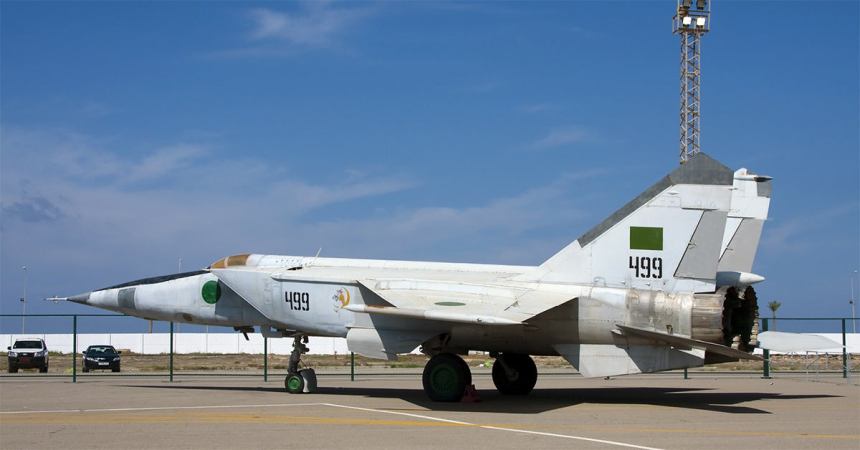The recent aerial bombardment of Syrian chemical weapons production facilities was one of epic proportions, featuring aircraft and warships from three countries — namely France, the United Kingdom, and the United States.
Reminiscent of the large Alpha strike flights of the Vietnam War, this attack formation consisted of dozens of aircraft, each with their own roles and objectives. From bombers to reconnaissance jets, supersonic high-performance fighters, and a 50-year-old electronic attack plane, the strike package employed a diverse array of aircraft to achieve overall success.
These are the aircraft that were involved in the attack:
Fighters
Fighter aircraft from the US, UK, and France were absolutely integral in making the entire strike mission a success. American F-22 Raptors, F-16 Fighting Falcons, and F-15C Eagles from U.S. Air Forces in Europe covered the attack force alongside British Eurofighter Typhoons and French Mirage 2000s. Armed with air-to-air missiles, they loitered nearby, waiting patiently to deal with any aerial threats.

(U.S. Air Force photo by Armando A. Schwier-Morales)
The British and French aerial strike force consisted of Panavia Tornado supersonic attack jets and Rafale multi-role fighters. Both were armed with the Storm Shadow/SCALP air-launched cruise missile, which has a range of over 600 miles.
Bombers
A small element of B-1B Lancer supersonic bombers were responsible for carrying out the American contribution to the aerial attack mission, using JASSM-ER air-launched missiles. These behemoth aircraft have previously operated in Syria, Iraq, and Afghanistan, supporting troops on the ground with devastating close air support.

(US Air Force)
Built during the Cold War as a way for the US Air Force to avoid air defenses and deliver nuclear weapons to their targets, the Lancer, more affectionately known as the ‘Bone,” eventually moved out of its nuclear attack role as the Soviet Union fell. Today, it carries targeting pods and scores of conventional, “smart” munitions, flying as an on-call bomb truck for ground units.
The Bone used JASSM-A missiles in the attacks.
Electronic Attack
By far, one of the most interesting additions to the strike force was a sole EA-6B Prowler, a four-seater electronic attack jet flown exclusively by the Marine Corps. The Prowler originally entered service with the US Navy and Marines in the early 1970s, serving as anti-radar “jammers.” The Marines plan on operating the Prowler into 2019, when they’ll retire them in favor of the electronic warfare capabilities of the F-35 Lightning II.

(Jerry Gunner)
During the strike mission, the Prowler accompanied the American attack force as a guardian of sorts, preventing them from being targeted by Syrian (and potentially Russian) air defense radars mated to surface-to-air missiles. Marine Prowlers have been previously deployed to the Syrian theater to conduct similar protection-type missions.
AWACS
France sent a pair of E-3F Sentry AWACS (Airborne Warning And Control System) jets from Avord Air Base to the area, where they constantly scanned and monitored the skies for nearby Russian, Syrian, and civilian aircraft.

(US Air Force)
The Sentry, produced by Boeing, began service with the US Air Force in the early 1970s as a replacement for older Warning Star aircraft. Essentially flying radar pickets, these aircraft come with a massive rotating radar dome affixed above the fuselage and a whole suite of sensors and communications gear that allows it to feed information to friendly aircraft operating nearby.
Tankers
The aerial refueling community in the US has a saying, “nobody kicks ass without tanker gas!” This was certainly true during the Syrian strike mission. American and French KC-135R and C-135FR Stratotankers were on-station, a safe distance away from the action, ready to refuel allied aircraft as needed.

(US Air Force)
Built by Boeing and operating off the same platform as the E-3 Sentry, the KC-135 has flown for the USAF since the late 1950s and will likely remain in service for decades to come. This legendary workhorse has seen action from Vietnam to Operation Desert Storm and still actively participates in coalition operations against ISIS today in the Middle East.
Reconnaissance
In the hours before the attack, a single RQ-4 Global Hawk drone was briefly tracked flying near Syria and Lebanon, according to David Cenciotti of The Aviationist. Additionally, an RC-135V Rivet Joint aircraft was also operating in the area at the time, likely generating data and gathering information in advance of the strike mission.

(US Air Force)
Global Hawks, aptly named for their jaw-dropping endurance and range, have flown with the US Air Force for the past 17 years, functioning as a versatile surveillance platform over combat zones across the Middle East. The Rivet Joint, on the other hand, is a manned signals intelligence aircraft used for reconnaissance purposes on classified missions across the world.


























